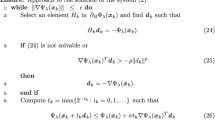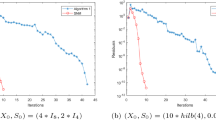Abstract
We introduce a new, one-parametric class of NCP-functions. This class subsumes the Fischer function and reduces to the minimum function in a limiting case of the parameter. This new class of NCP-functions is used in order to reformulate the nonlinear complementarity problem as a nonsmooth system of equations. We present a detailed investigation of the properties of the equation operator, of the corresponding merit function as well as of a suitable semismooth Newton-type method. Finally, numerical results are presented for this method being applied to a number of test problems.
Similar content being viewed by others
References
S.C. Billups, Algorithms for Complementarity Problems and Generalized Equations, Ph.D. Thesis, Computer Sciences Department, University of Wisconsin, Madison, WI, 1995.
F.H. Clarke, Optimization and Nonsmooth Analysis, John Wiley & Sons: New York, NY, 1983 (reprinted by SIAM, Philadelphia, PA, 1990).
R.W. Cottle, J.-S. Pang, and R.E. Stone, The Linear Complementarity Problem, Academic Press: Boston, 1992.
T. De Luca, F. Facchinei, and C. Kanzow, “A semismooth equation approach to the solution of nonlinear complementarity problems,” Mathematical Programming, vol. 75, pp. 407-439, 1996.
S.P. Dirkse and M.C. Ferris, “MCPLIB: A collection of nonlinear mixed complementarity problems,” Optimization Methods and Software, vol. 5, pp. 123-156, 1995.
F. Facchinei, A. Fischer, and C. Kanzow, “Inexact Newton methods for semismooth equations with applications to variational inequality problems,” in Nonlinear Optimization and Applications, G. Di Pillo and F. Giannessi (Eds.), Plenum Press: New York, NY, 1996, pp. 125-139.
F. Facchinei, A. Fischer, and C. Kanzow, “A semismooth Newton method for variational inequalities: The case of box constraints,” in Complementarity and Variational Problems, State of the Art, M.C. Ferris and J.-S. Pang (Eds.), SIAM: Philadelphia, PA, pp. 76-90.
F. Facchinei and J. Soares, “A new merit function for nonlinear complementarity problems and a related algorithm,” SIAM Journal on Optimization, vol. 7, pp. 225-247, 1997.
M.C. Ferris, Private communication, September 1996.
M.C. Ferris and C. Kanzow, “Recent developments in the solution of nonlinear complementarity problems,” Preprint, in preparation.
M.C. Ferris and J.-S. Pang, “Engineering and economic applications of complementarity problems,” SIAM Review, vol. 39, pp. 669-713, 1997.
M.C. Ferris and T.F. Rutherford, “Accessing realistic mixed complementarity problems within MATLAB,” in Nonlinear Optimization and Applications, G. Di Pillo and F. Giannessi (Eds.), Plenum Press: New York, NY, pp. 141-153.
A. Fischer, “A special Newton-type optimization method,” Optimization, vol. 24, pp. 269-284, 1992.
A. Fischer, “Solution of monotone complementarity problems with locally Lipschitzian functions,” Mathematical Programming, vol. 76, pp. 513-532, 1997.
A. Fischer and C. Kanzow, “On finite termination of an iterative method for linear complementarity problems,” Mathematical Programming, vol. 74, pp. 279-292, 1996.
S.A. Gabriel and J.J. Moré, “Smoothing of mixed complementarity problems,” in Complementarity and Variational Problems, State of the Art, M.C. Ferris and J.-S. Pang (Eds.), SIAM: Philadelphia, PA, pp. 105-116.
L. Grippo, F. Lampariello, and S. Lucidi, “A nonmonotone linesearch technique for Newton's method,” SIAM Journal on Numerical Analysis, vol. 23, pp. 707-716, 1986.
C. Kanzow, “Semismooth newton-type methods for the solution of nonlinear complementarity problems,” Habilitation Thesis, Institute of Applied Mathematics, University of Hamburg, Hamburg, April 1997.
C. Kanzow and M. Fukushima, “Equivalence of the generalized complementarity problem to differentiable unconstrained minimization,” Journal of Optimization Theory and Applications, vol. 90, pp. 581-603, 1996.
B. Kummer, “Newton's method for non-differentiable functions,” in Mathematical Research, Advances in Mathematical Optimization, J. Guddat et al. (Eds.), Akademie-Verlag: Berlin, Germany, 1988, pp. 114-125.
R. Mifflin, “Semismooth and semiconvex functions in constrained optimization,” SIAM Journal on Control and Optimization, vol. 15, pp. 957-972, 1977.
J.J. Moré and W.C. Rheinboldt, “On P-and S-functions and related classes of n-dimensional nonlinear mappings,” Linear Algebra and its Applications, vol. 6, pp. 45-68, 1973.
J.-S. Pang, “Newton's method for B-differentiable equations,” Mathematics of Operations Research, vol. 15, pp. 311-341, 1990.
J.-S. Pang, “A B-differentiable equation-based, globally and locally quadratically convergent algorithm for nonlinear programs, complementarity and variational inequality problems,” Mathematical Programming, vol. 51, pp. 101-131, 1991.
J.-S. Pang and L. Qi, “Nonsmooth equations: Motivation and algorithms,” SIAM Journal on Optimization, vol. 3, pp. 443-465, 1993.
L. Qi, “Convergence analysis of some algorithms for solving nonsmooth equations,” Mathematics of Operations Research, vol. 18, pp. 227-244, 1993.
L. Qi and J. Sun, “A nonsmooth version of Newton's method,” Mathematical Programming, vol. 58, pp. 353-367, 1993.
S.M. Robinson, “Strongly regular generalized equations,”Mathematics of Operations Research, vol. 5, pp. 43-62, 1980.
Ph.L. Toint, “Non-monotone trust-region algorithms for nonlinear optimization subject to convex constraints,” Mathematical Programming, vol. 77, pp. 69-94, 1997.
P. Tseng, “Growth behaviour of a class of merit functions for the nonlinear complementarity problem,” Journal of Optimization Theory and Applications, vol. 89, pp. 17-37, 1996.
N. Yamashita and M. Fukushima, “Modified Newton methods for solving a semismooth reformulation of monotone complementarity problems,” Mathematical Programming, vol. 76, pp. 469-491, 1997.
Author information
Authors and Affiliations
Rights and permissions
About this article
Cite this article
Kanzow, C., Kleinmichel, H. A New Class of Semismooth Newton-Type Methods for Nonlinear Complementarity Problems. Computational Optimization and Applications 11, 227–251 (1998). https://doi.org/10.1023/A:1026424918464
Issue Date:
DOI: https://doi.org/10.1023/A:1026424918464




